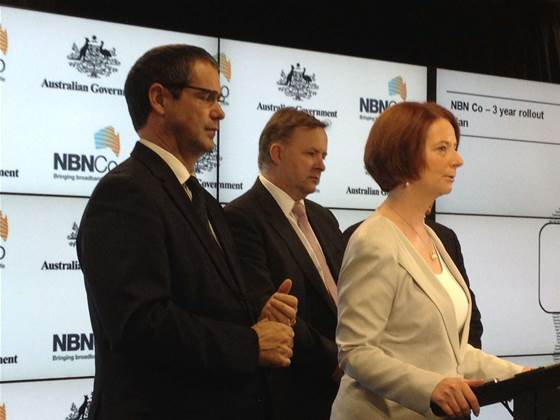NBN Co has revealed plans to begin or complete construction for more than 3.5 million premises by the middle of 2015 as part of the first phase of its "large-scale rollout".

It has already revealed plans to begin construction at 758,000 premises by the end of this year as well ambitions to complete construction in Tasmania by 2015.
The new plan forms part of a bid to reduce further delays in the network build.
NBN Co will pass up to 6000 premises a week at the height of this rollout phase which will ultimately reach one-third of Australian premises destined to receive fibre connections, through sub-contractors signed for each state.
The three-year plan provides an indication of the approximate areas to receive fibre connections.
But NBN Co has not provided completion dates for the 1500 individual sites to be included in the indicative rollout plan, and would not provide details on where the network will reach at the time of the federal election late next year.
CEO Mike Quigley said the full rollout would take approximately a decade but would not comment on any changes to an initial plan to complete the rollout by 2018.
An updated corporate plan is due for submission to the Government in May, reflecting delays in the network rollout as a result of regulatory hurdles and the long-spanning negotiations with Telstra.
"We'll be trying to do everything we can to recover that start delay and keep right on track," Quigley said.
"We can't commit to that but overall it's about a decade-long rollout. We obviously continue to ramp to achieve by June 2015 that total of 3.5 million premises.
Sites
A total of 1500 communities are now slated to receive fibre connections under the three-year rollout plan.
Some 400 work teams and a total 16,000 workers will be used to roll out the network over that period. They include:
- 1,010,700 premises in NSW;
- 691,600 in Victoria;
- 678,600 in Queensland;
- 429,200 in Western Australia;
- 327,300 in South Australia;
- 135,300 in the ACT;
- 65,200 in the Northern Territory; and
- 209,100 in Tasmania
Though the new sites provide an indication of where the network will roll out over the next three years, exact locations of the fibre rollout within those suburbs will not be made clearer until NBN Co sub-contractors begin detailed design of the area.
The network builder says it will take approximately 12 months to complete the rollout in a specific area once that design has begun and that the rollout will take place in modular packages covering about 3000 premises each.
Site choices
Communications minister Stephen Conroy sought to dispel persistent rumours of political machinations behind the chosen rollout sites.
The first three-year rollout phase will reach 67 current Labor electorates, 61 under Liberal leadership and all six cross-bench seats under the current Government.
Quigley said the rollout sites had been chosen on current completion dates, a balance of regional and metropolitan areas, and prioritisation of growth corridors over the next three years.
The company has also prioritised building of the transit network, expected to also be completed that year, and links needed for the fixed wireless and long-term satellite components of the network.
The rollout sites had been "sequenced… to minimise cost and operate as efficiently as possible", according to Quigley.
"The planners had no idea about electoral boundaries and weren't even interested," he told a media conference Thursday.
Choice of sites has also been linked to the availability of Telstra infrastructure included in the $9 billion agreement with NBN Co, only finalised in February after more than 18 months delay.
Battery backups
Despite plans to roll out to 3.5 million premises by 2015, a key decision on whether each house will mandatorily receive a backup battery is yet to be decided by the Federal Government.
The batteries, installed alongside the customer equipment connecting to the NBN, provide up to eight hours charge for one of the voice ports, allowing voice calls in case of a power outage or emergency provided the phone itself does not require power to operate.
The Government's interim decision to mandate their installation has been widely criticised as highly costly, providing few benefits and likely to add significantly to unwanted waste when the batteries reach their end-of-life in five years' time.
NBN Co has publicly voiced indications it prefers an opt-in model, providing batteries only to those who specifically request it or potentially to those who require it for medical purposes.
Senator Conroy said the Government had continued discussions with NBN Co and expected a decision before the finalisation of the updated corporate plan in May.
"No final decision has been made on that," he said.
It is expected the decision will factor into the cost of installing fibre at individual premises across the rollout.


_(22).jpg&h=140&w=231&c=1&s=0)


_(20).jpg&h=140&w=231&c=1&s=0)



_(26).jpg&w=100&c=1&s=0)

 iTnews Executive Retreat - Security Leaders Edition
iTnews Executive Retreat - Security Leaders Edition












_(1).jpg&h=140&w=231&c=1&s=0)



